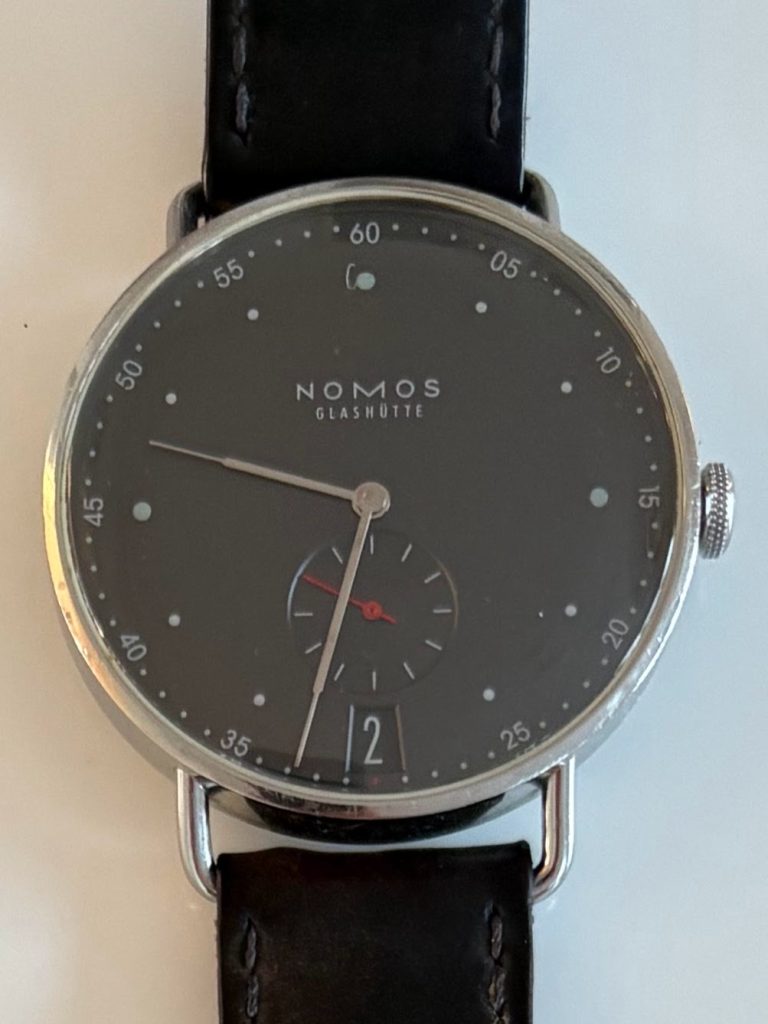| Brand | Nomos |
| Model | Metro 38 Datum |
| Year | 2014 |
| Caliber | DUW 4101 |
| Details | Size 38/8/19 (w/h/lug) |
| Links | Article about Nomos |
| Search |
Nomos: Founding and History
Nomos is an independent German watchmaker, based in Glashütte, Saxony, Germany. The small town of 7,000 is squeezed into a valley about 2 hours south of Berlin, and is dotted with almost a dozen watchmakers and manufacturers, including A Lange & Sohne and Glashütte Original. While A Lange has the highest revenue of the Glashütte manufacturers, Nomos delivers the most watches. Today, Nomos is a member of the Deutscher Werkbund, an association of German artists, architects and designers. Founded in 1907, it helped give rise to the Bauhaus movement and associated design ethos of the early- to mid-1900s.
Nomos was founded by Roland Schwertner in January 1990 — a photographer and computer geek with no watch experience — just two months after the fall of the Berlin Wall. It was founded at the same time as the modern A Lange & Sohne, and Glashütte watchmaking began to experience a renaissance that persists to this day, even as the Swiss watch industry has struggled at times.
While A Lange has been owned by Richemont Group and Glashütte Original has been owned by Swatch Group since 2000, Nomos remains an independent manufacturer — one of the few true independents in the watchmaking world, and perhaps the only independent making watches at prices accessible to the general public (Patek Phillipe, Audemars Piguet, F.P. Journe, and other small haute horology operations dot the list of independent manufacturers; this also includes other Glashütte watchmakers like Moritz Grossman). Like A Lange, the Nomos name had existed before, but only for a short run in the early 1900s.
The Nomos headquarters — home to most of the company’s 300 employees — is a converted train station in an idyllic little spot in Glashütte, adjacent to A Lange, Glashütte Original and not far from the town’s other watchmakers (you can walk across the entire town in about 15 minutes). The rest of the company’s employees work at the brand’s in-house creative studio, Berlinerblau, in central Berlin.
For a watch to stamp itself with the coveted “Glashütte” name, at least 50 percent of its value must be produced locally, a feat that Nomos took years to achieve as it worked to move its movement manufacturing in-house and away from ebauche movements.
Nomos Movements: Going In-House
From its launch in 1992 through early 2005, Nomos used Swiss ETA or Peseux ebauche movements. The movements were based on the Peseux 7001, though with some finishing done in Glashütte style: Solar grinding on the crown and barrel wheels, “Glashütte stripes on the bridges, and blued screws. The plates were also rhodinated to become resistant to oxidation and later blasted and gilded.
Due to these modifications, ETA requested that Nomos not use their name on the movement as early as 1997, so Nomos began re-working the movements even more. In March, 2002, the company gave this modified calibre a new name: Nomos 1 T. This calibre replaced the plate and balance cock of the Peseux with gold plated pieces decorated with perlage at the Nomos facility. Regulation was now done using Triovis fine regulation, thus the “T” in the name. The next major shift was the introduction of the Nomos 1 TSP and its descendants, which featured Glashütte style three-quarter places.
Finally, in 2005, Nomos released its first watch with an in-house movement: the Tangomat. At the same time, the Tangente’s manual movement was also converted to an in-house manufacture. Nomos was finally doing much greater than 50 percent of its watchmaking in Glashütte, and could justifiably join the ranks of genuine Glashütte manufacturers.
The Nomos Epsilon was the first self-winding movement (in the Tangomat), and the Nomos Alpha (in the Tangente) the first manual movement:

Both movements feature three-quarter Glashütte plates, hacking seconds, Glashütte stripes, tempered blue screws, rhodium plated surfaces with stripes and “Nomos” perlage, and the “Glashütte” sunburst around the crown wheel. The movements still used an externally soured escapement and would continue to until 2014.
In 2013, Nomos introduced a new line of calibres, called “Deutsche Uhrenwekre” (DUW), meant to signify Nomos’ increased capacity as a manufacturer in its own right.
Then, in 2014, Nomos announced that it had developed a completely in-house escapement: the Nomos Swing System. Nomos introduced its completely in-house movement at Baselword 2014 with the launch of the Metro.
Manufacturing the Swing System is an incredibly precise process, and to this day, only a few watchmakers at Nomos are capable of properly executing the process. Not only was the movement a noteworthy achievement for the brand; the design itself was lauded by watch enthusiasts and designers around the world. Designed by legendary industrial designer Mark Braun, the Metro was a colorful break from some of Nomos’ more staid designs. It somehow conjures up images of the 1930s just as well as it does the 2330s.
